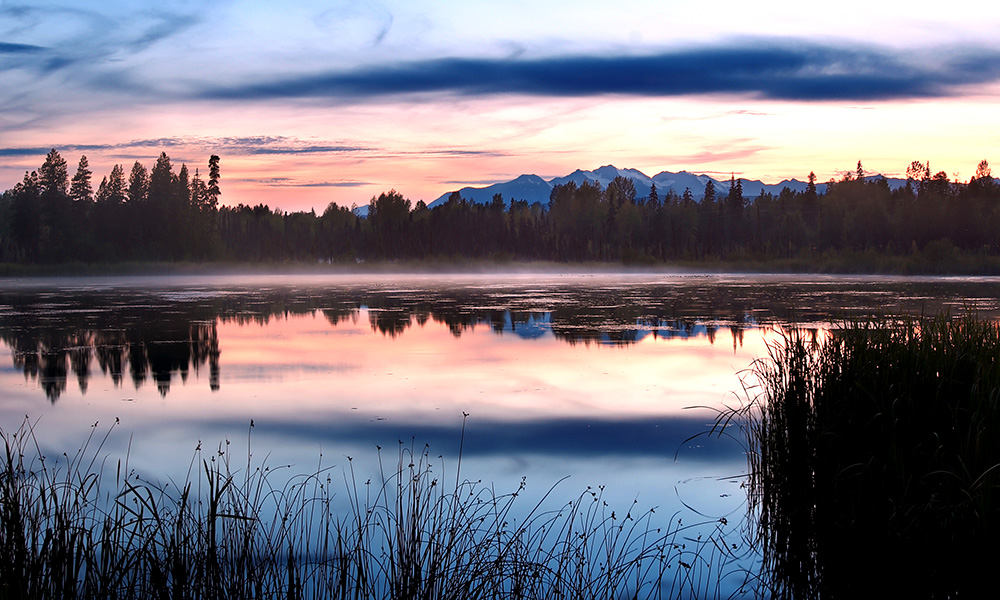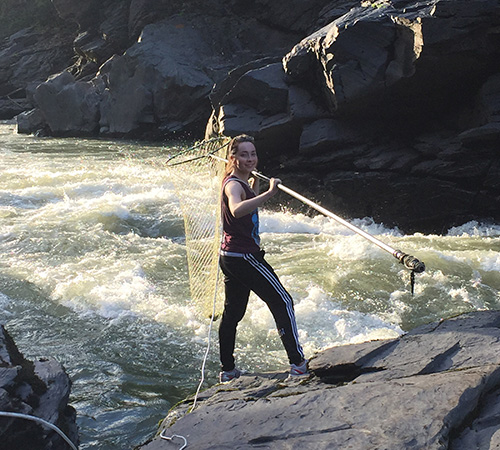
JANNA WALE WILL ALWAYS REMEMBER THE FIRST WEEK OF HER MASTERS PROGRAM, and showing her father the UBC Okanagan campus where she would study climate change and its impact on Indigenous peoples.
“He looked at all the posters on the wall, and he turned to me and said, ‘You’ve come a long way since Gitanmaax Nursery School,’” she says, smiling.
At the same time, she never really left. Her home, and what’s happening to it, is one of the reasons she decided to study how Indigenous people relate to their land through climate change.
Wale is a Gitxsan woman from Gitanmaax First Nation who graduated from UBCO in 2022 with a Master of Interdisciplinary Graduate Studies (IGS) degree in Sustainability. It was accomplished almost entirely through pandemic restrictions, adding a layer of complexity to her work.
Her experience is an example of how UBCO’s IGS program can be adapted. Wale was able to blend UBC’s longstanding academic tradition with her own Indigeneity through UBCO’s close-knit, interdisciplinary approach.
Wale is now a research associate with the Ottawa-based Canadian Climate Institute, but working remotely in Nanaimo, the traditional territory of the Coast Salish Peoples and Snuneymuxw First Nation.
“My work is currently focused on research related to climate adaptation in Canada,” she says. “In essence, we’re researching actions and policy levers that will help Canada adapt to the coming future.”

The sun sets on Seeley Lake in the traditional territory of the Gitxsan people near Hazleton, BC.
Prior to Wale’s time at UBCO, she earned a Bachelor of Natural Resource Sciences degree with honours from Thompson Rivers University in Kamloops. But her academic curiosity started with a simple question: Where are the salmon?
“I’d go home and watch my father and my uncles dip-net fishing,” she says, “but it seemed like every year they would return with fewer and fewer salmon.
“Coming and going from my community over the brief span of my life really emphasized the changes we were seeing because of climate change throughout our territory. When I graduated from high school, I wanted to take a program where I could make a difference. I wanted to make sure that future generations could enjoy the salmon the same way I’ve been able to.”
Salmon are vital to the Gitxsan. They are known as The People of the River Mist. Gitanmaax rests at the fertile junction of the Skeena, Nass and Bulkley rivers near the colonial community of Hazelton in northern BC. The Gitanmaax First Nation’s logo features a salmon, traditional dip net and a torch—Gitanmaax means The People Who Harvest Salmon Using Torches.
Wale’s research at UBCO turned to climate resiliency of Indigenous people using a seasonal rounds model. In essence, she wanted to understand how Indigenous peoples’ perception of the seasons—when they begin and end—is being influenced by climate change.
“A seasonal round is the annual cycle of land-based practices that have sustained these Nations since time immemorial—despite the recent shifts that we are collectively experiencing as the climate changes,” she writes in a paper on the Canadian Climate Institute website called, Gitxsan Rez-ilience: Understanding climate resilience as Naadahahlhakwhlinhl (interconnectedness).
She collected her data from her Gitxsan home and from the Secwépemc Nation, where she spent much of her adult life. Both case study nations are experiencing climatic changes, but in dramatically different ways—which will affect their resilience to future climatic changes.
Importantly, her master’s research highlighted the fundamental differences between the Indigenous and colonial approaches to climate and resilience. Colonial powers may view resilience as bending the land to their needs; settlers moved mountains to build railways and mined coal to power locomotives.
The Gitxsan grant every plant, animal and mineral the same respect. That Indigenous view of the land is grounded in relationship and reciprocity, and is how the Gitxsan have weathered climate fluctuations to the environment since first occupying their home after the last glaciers retreated 15,000 years ago.
“Gitxsan people know their place as a part of the Land and have a sense of responsibility to the land. The Gitxsan community members I spoke with reinforced concepts of connection, respect, holism, balance and ceremony, which contribute to good stewardship of territories,” Wale writes.
“This warming has caused significant changes in Gitxsan territory,” Wale adds, “and is shifting the Gitxsan seasonal cycle of use. These changes to annual cycles and patterns, the seasonal round, are one more example among many of the consequences of the lack of balance and harmony in our relations with the Earth.”

Janna Wale uses a traditional dipnet to fish at Kitsgegas.
Dr. Lael Parrott, who was Wale’s thesis advisor, said the willingness of the university to create the intellectual space for Wale to complete such original research is an encouraging sign.
It seemed a fitting connection between the two worlds that Nathan Matthew, former chief of Simpcw First Nation and current chancellor of TRU, sat on her supervisory committee.
“Every step of the way on her journey to a master’s degree, Janna wove her Indigenous perspective and methodology into her research,” says Parrott. “She included beautiful Indigenous art—drawings of the seasonal round, Indigenous maps—into her thesis. Perhaps most importantly, she gave equal footing to traditional story work, the voices of community members and academic approaches.”
Being able to unite those perspectives was imperative to completing her master’s degree at UBCO, Wale says. However, she’s also being honest when she says it wasn’t always easy. It required some convincing and planning, but Wale says she’s proud of creating space for her Indigenous self and culture.
“I would say it challenged me,” she admits, “but I’m proud of what I accomplished. You forget just how much of an achievement it is to earn your master’s degree—I could get so caught up in ‘work mode’ sometimes that I didn’t stop to take it all in. But it was certainly worth it. Going through this will make it easier for the next person coming after me.”

